Maps are an essential part of any road trip. You’d most likely be lost without them, which would wreck your journey.
Yet, only a few marketers create a customer journey map when developing a content strategy.
In these times of quick-changing trends and ever-evolving buyer preferences, you need to anticipate the motivations and needs of your prospects to improve the quality of their experiences.
By doing that, you move leads from an awareness phase to an interest phase in the sales funnel. And no, you don’t have to drain your resources, time, and energy for creating a map.
Let us help you uncomplicate the process of customer journey mapping.
Table of contents
- What is a customer journey map?
- Benefits of customer journey map
- How to align customer journey with email marketing?
- Steps to create journey maps
- 8 customer journey mapping tools
- Customer journey map best practices
- Start mapping journeys for your buyer personas
What is a customer journey map?
A customer journey map uses storytelling to visually represent the steps taken by a customer when interacting with your product or service. In fact, no storytelling tool defines all the points where customers interact with you like this one.
It helps you get inside your prospects' heads, making them the heroes of the story. Below are some components included in journey maps:
Customer personas: A profile of your target audience summarizing their demographic, lifestyle, needs, habits, and frustrations.
Stages: Phases which your customer passes through, Consideration, Evaluation, Closure, and Post-Purchase.
Touchpoints: Individual transactions through which a prospect interacts with your brand, like product demos, social media channels, chatbots, store visits, paid ads, and website clicks.
Emotions and pain points: Representation of how a customer feels at a certain stage.
Customer actions: The actions you want a customer to take, like clicking a paid ad, downloading an eBook, contacting customer service, requesting a demo, or subscribing to your newsletter or blog.
Benefits of customer journey map
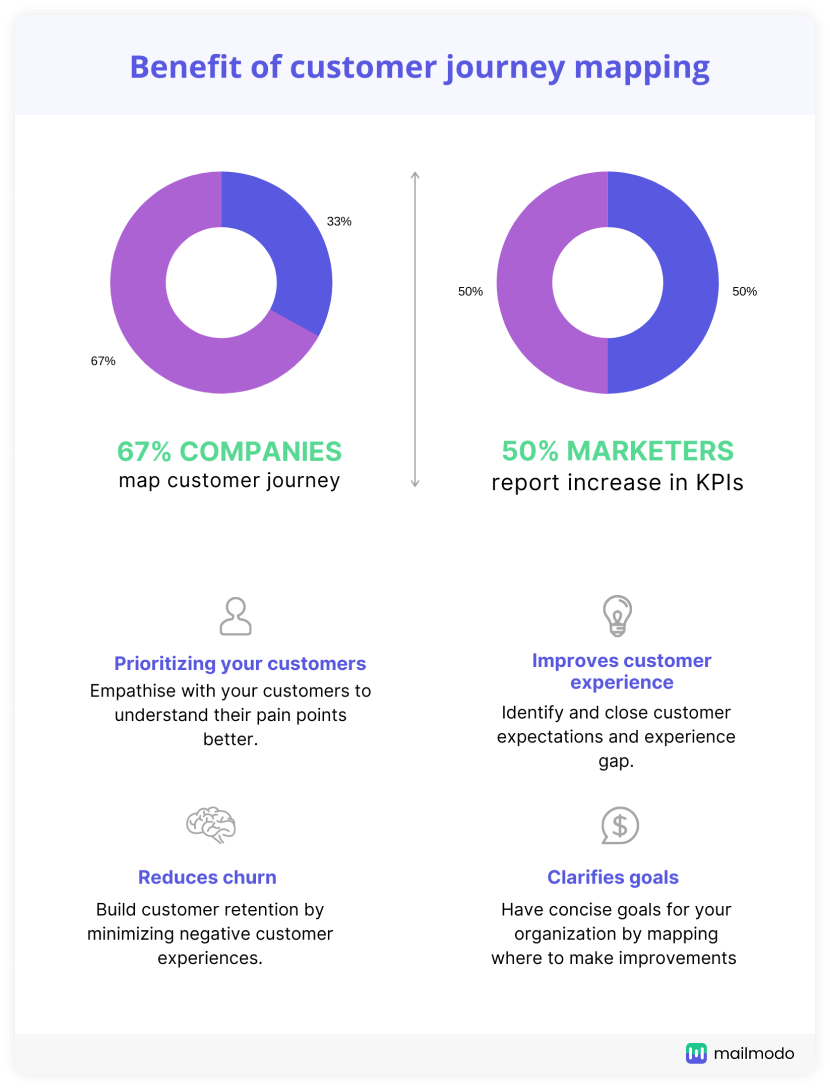
Journey maps drive value in 4 measurable ways:
Prioritizing your customers: As per PwC, 1 in 3 customers bid goodbye to a brand after one bad experience. By visualizing their challenges, pain points, questions, and buying process, the process of creating a cohesive, customer-centric brand strategy is simplified.
Reduces churn: Minimizing negative customer experiences with journey mapping provides opportunities to improve retention and reduce churn.
Improves customer experience: McKinsey identifies the customer experience and expectations gap at 21% in the retail industry, which you can bridge by visually demonstrating solutions on the map.
Clarifies organizational goals: Concise goals bring teams together. There are fewer chances of friction by mapping the task to be executed by each department.
How to align customer journey with email marketing?
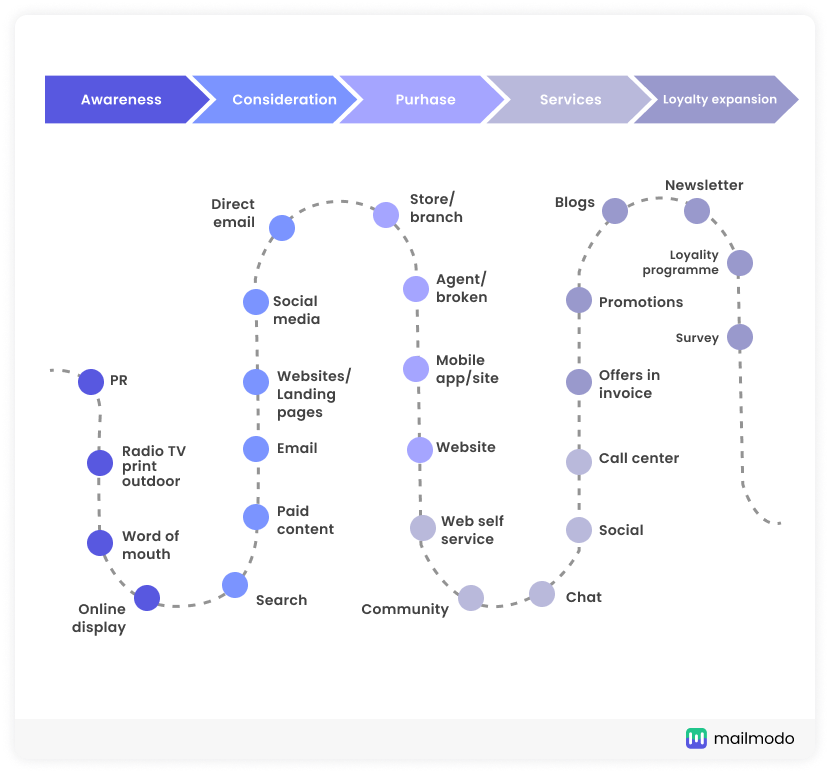
Start by aligning these 5 stages in customer journeys with email marketing.
Awareness: Stand out of the crowd with your welcome email series in the awareness stage. Besides sharing what you do, you can send interactive elements like live discounts and scratch the card using AMP emails to set your customer’s expectations.
Consideration: In this stage, the prospect is considering making a purchase. Let’s say, for whatever reason, they abandon their cart. Bring them back by creating an abandoned cart workflow.
We at Mailmodo help businesses trigger automated AMP emails based on a user’s behavior. Don’t take us at our word–check out our success story of how Traya got a 15% cart recovery rate. Inspired? Book a free demo to target shopping cart abandoners today.
Purchase: By enabling direct, in-mail checkouts and reducing the steps a user has to take, AMP emails lead to a conversion rate that's 3X higher compared to regular email campaigns. These can also update dynamically based on product availability.
Service: The journey doesn’t end once your customer buys your product or service. Ensure you send them a thank you note and product follow-up emails.
Loyalty expansion: Our eCommerce functionality is equally proficient for reorders and renewals. On a side note, you can also include personalized product recommendations in a carousel inside the email.
Related guide: Everything you need to know about email marketing
Steps to create journey maps
Creating a customer journey map for understanding user trends and assigning ownership of touchpoints to teams is a 5-step process.
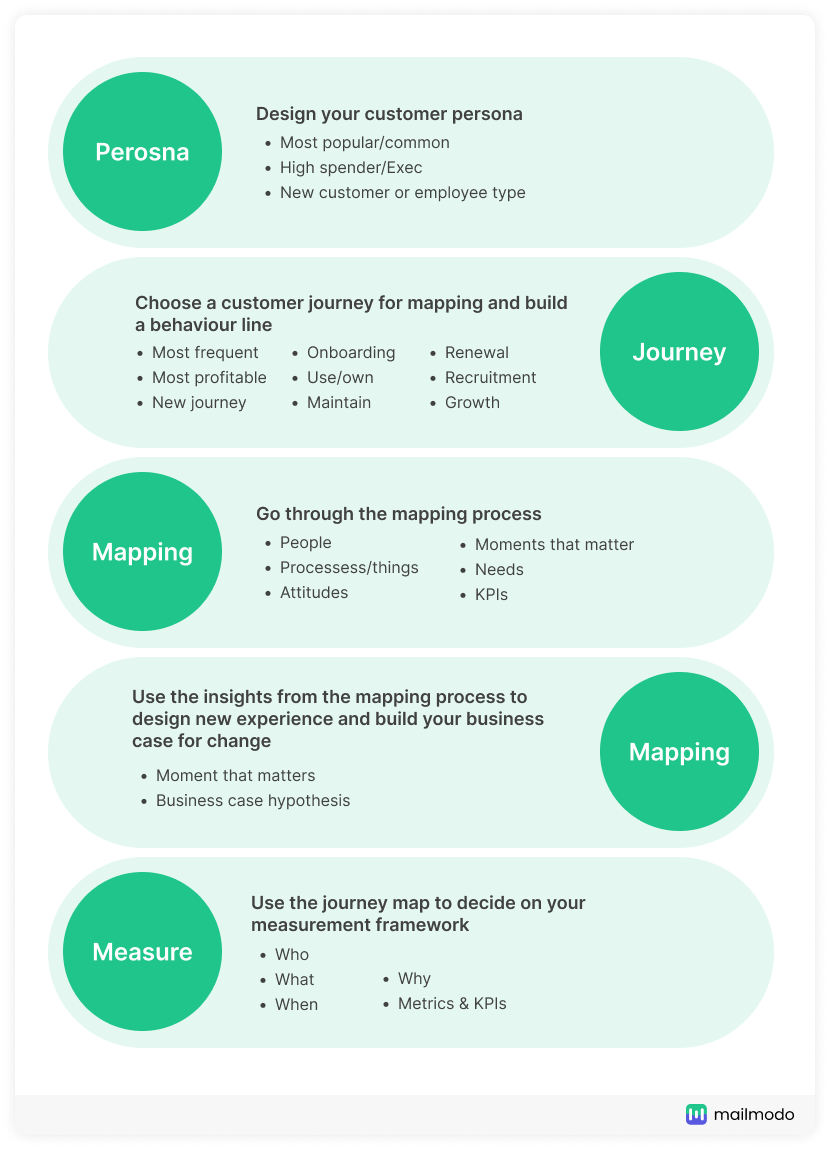
1. Design your customer persona
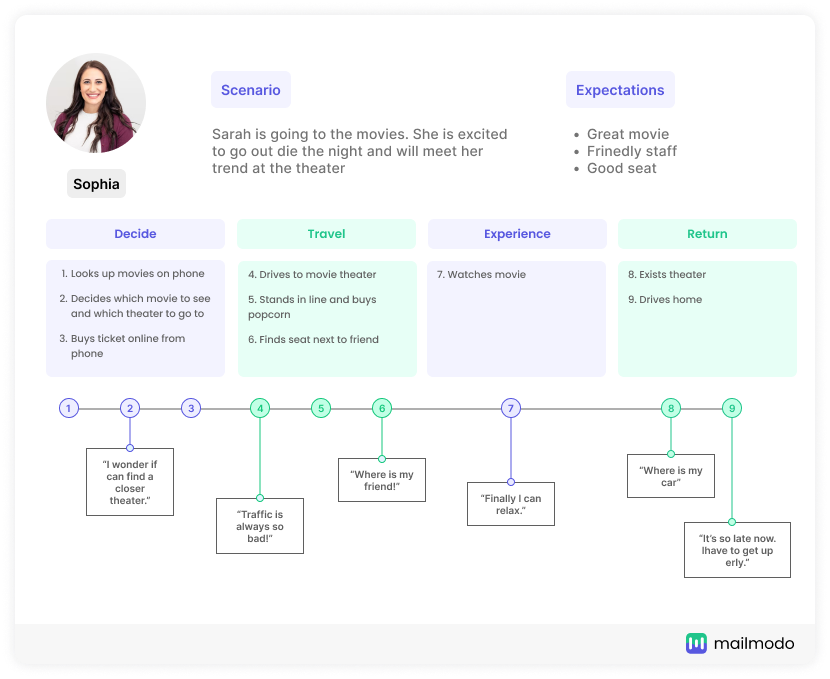
You can't rely on tracking stats alone to research your average customer. You’ll need to obtain data from them by:
Emailing them a survey (one which they fill in the mail without any redirects to assure you of a response)
Gathering Net Promoter Score (NPS) and Customer Satisfaction (CSAT) data
Surveying customer support and complaint logs
Conducting interviews and user testing feedback
Monitoring discussions around your organization on social media
Ask questions like:
[CSAT]: How do you feel about this feature?
[CSAT]: How do you feel about the checkout process?
[CSAT]: Did you face any problems reaching out to customer support?
[NPS]: How likely are you to recommend this product to your friends or family?
[NPS]: How likely are you to recommend this solution to your colleagues?
Here’s an NPS survey template you can use to visualize results from your feedback forms. These come in super handy for sharing with your team.
Related guide: How to use an NPS rating widget in your template
2. Choose a customer journey
Your next step should be to identify the paths your visitors may take.
If your visitor’s a member, the first thing they may do is log in.
They may also visit to browse, search for a product or service, compare products, etc.

Once you’re through with that, you need to identify touchpoints (digital or in-person) where visitors come in contact with your brand.
Draft a different journey map template for different use cases, including:
Current state: Visualize your customer’s experience as it is today
Future state: Map what the customer’s journey will look like, focusing on future wants and aspirations
Day in the life: Visualize your customer’s daily routine in a chronological manner
Service blueprint: Reflects the things that need to happen behind the scenes to build the customer journey
Empathy map: Map the wants, needs, actions, and thoughts of a specific type of customer
3. Go through the mapping process
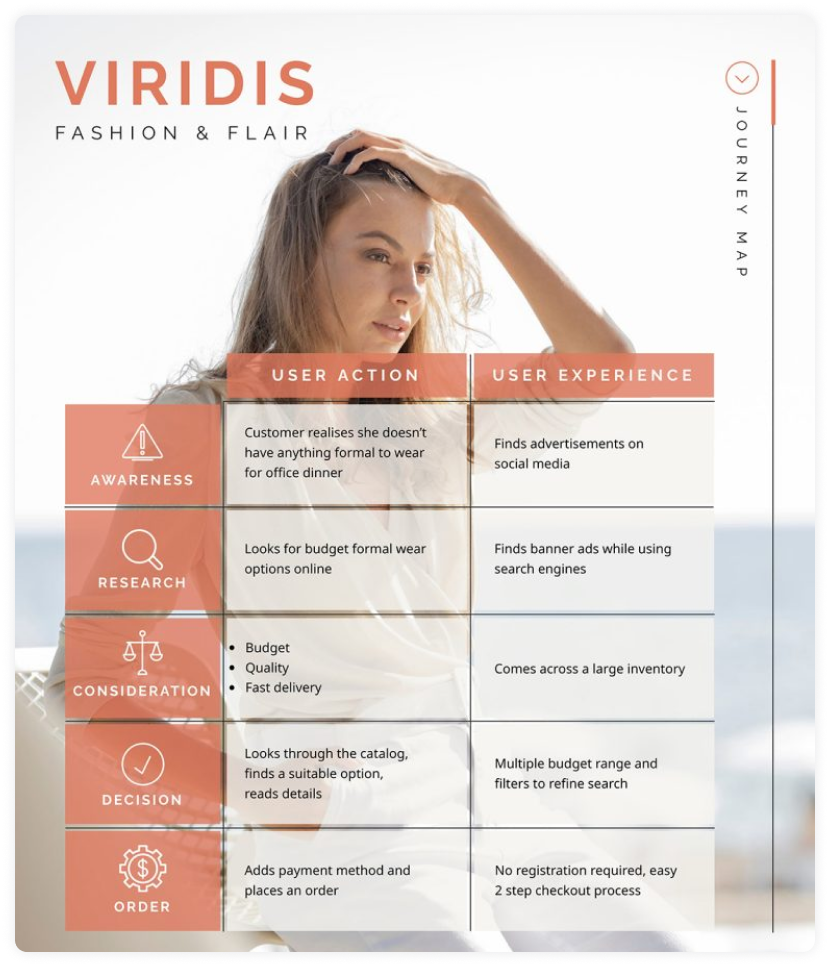
Your third step is to organize the information you’ve gathered into stages, just like this eCommerce fashion company did.
If your customer-persona is a problem-solver, they may choose self-service over reaching out to a customer service representative. You can anticipate your customer behavior by identifying:
What are your customer’s goals?
What type of experience are they looking for?
What stages are needed to give them that?
How do they feel during each touchpoint?
Pro tip: Set Key Performance Indicators (KPIs) to put benchmarks in your customer journey map for tracking your progress.
Related guide: Email Marketing Metrics: Benchmarks and How to Measure Them
4. Design new experiences
If Netflix can go from mailing DVDs in 1998 to becoming the king of streaming, you too can disrupt your business model. Put together a mapping team, experiment with different hypotheses on improving the customer experience, and test, test, test. Mapping your current state will also help you identify the red flags in the experience.
5. Decide on your measurement framework
Now that you’ve visualized the current state of your customer journey, it is time to analyze the results.
Use the mapping tools listed below to fix the obstacles in your roadmap.
Show the solutions on the map with the help of customer intelligence and digital experience.
Present them company-wide to bring everyone up to speed with the roadmap for improving your customer journey.
8 customer journey mapping tools
We’ve rounded up 8 mind-mapping and analytics tools to help you create stellar visual assets:
UXpressia - Collaborative persona building, mind-mapping, and customer journey mapping tool
Mapovate - Journey mapping software with a real-time voice of customer analytics
Smaply - Intuitive digital tool for journey mapping, persona, and stakeholder map building
Lucidchart - Diagramming tool for designing organizational flowcharts
Touchpoint Dashboard - Drag and drop tool for the journey mapping process
Google Analytics - End-to-end website analytics tool
HotJar - Behavior analytics, website heatmaps, and survey creation tool
FullStory - Web analytics and data intelligence platform for qualitative and quantitative insights
Related guide: How To Use Heatmaps to Analyze Your Website Performance
Customer journey map best practices
OK, so we all agree that a #customerjourneymap is important for your company. Here is one of the most common errors: Build your map on your assumptions and feelings 😪
— Alejandra Cienfuegos (@heyiamAC) June 10, 2021
How to avoid this error: Do Your Research🤓
✔️ Make #surveys
✔️ Organize #focusgroups
✔️ Analyze your #stats
The following best practices will help you revise and refine your customer journey maps.
Focus on the 5E framework of journey mapping:
Entice: What attracted visitors to your website/app?
Enter: What are the first few actions they take?
Engage: What are their intended actions?
Exit: Do they complete the desired action or abandon the journey?
Extend: Does the customer come back for further purchases?
Audit your content strategy during the mapping process for finding topic gaps you need to create content to fill.
Work with employees from different departments in your company. Customer experiences are never created in isolation.
Drive your organization with a shared sense of ownership of customer relationships.
Start mapping journeys for your buyer personas
Ready to use survey data to create your customer journey maps? Check out our ready-to-use AMP survey templates. You can customize them using our drag-and-drop editor and integrate them with analytics and data intelligence tools.
Also, read our guide on NPS survey best practices to achieve actionable insights from your customers today!
What you should do next
Hey there, thanks for reading till the end. Here are 3 ways we can help you grow your business:
Talk to an email expert. Need someone to take your email marketing to the next level? Mailmodo’s experts are here for you. Schedule a 30-minute email consultation. Don’t worry, it’s on the house. Book a meet here.
Send emails that bring higher conversions. Mailmodo is an ESP that helps you to create and send app-like interactive emails with forms, carts, calendars, games, and other widgets for higher conversions. Sign up now and send 10k free emails/month. Sign up here.
Get smarter with our email resources. Explore all our knowledge base here and learn about email marketing, marketing strategies, best practices, growth hacks, case studies, templates, and more. Access guides here.

